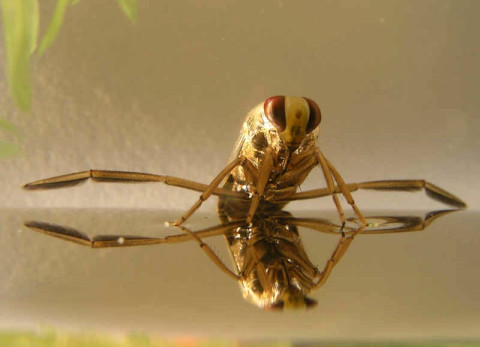Backswimmer most counted water animal during Dutch Ditch Days

Backswimmer most counted water animal during Dutch Ditch Days
This past weekend, thousands of children and adults took part in the first nationwide 'citizen science' ditch survey in the Netherlands. During the Dutch Ditch Days, they counted aquatic animals and/or performed simple water quality tests at more than 120 locations. The most counted water animals wer the backswimmer (a.k.a. water boatsmen), followed by the amphipods and the pond snails.
Based on the results of the water animal count, the average Dutch ditch would score 6.3/10 in terms of water quality. "It's a pass", says Froukje Rienks (NIOO-KNAW), "but only just. And you also have to take into account that most people surveyed only the nicer and more scenic ditches. So there's plenty of work to be done to improve water quality in the country as a whole."
Heartwarming enthusiasm
In addition to the top three, Rienks says she was glad to see that the citizen scientists who took part in the survey "also reported rarer specimens such as caddisfly or dragonfly larvae and diving beetles." But it was the enthusiasm with which they participated, says Marchien de Ruiter from Ditch Days organiser IVN Nature Educations, that was most heartwarming:
"'This one looks like a hammerhead shark', is what one child in Amsterdam's Vondelpark told me. And another one proudly showed me his water animal chart and said: 'Look, I've found almost all of them'." It bodes well for a follow-up next year, believes De Ruiter.
More tests next year
Plans for the next, expanded survey are already on the table. The 'citizen science' survey is to be repeated in the coming years, so that NIOO's researchers - who organised the survey together with IVN Nature Education - will eventually be able to obtain a comprehensive picture of the state of health of Dutch ditches.
In addition, a number of new, simple tests that participants will be able to perform are already about to enter the pilot stage. These include tests over a longer period to establish the temperature of the ditch, the light levels and information about the natural decomposition processes taking place.
(Text continues below pictures)
Why this survey?
Ditches are of vital importance for biodiversity. Insects depend on the natural habitat that is found in and around ditches, and so do the birds that feed on those insects. Moreover, ditches form a network connecting nature areas, allowing animals to migrate from one to another with relative ease. This could become increasingly important as the climate changes.
The Netherlands boasts no less than 300,000 km of ditches - a staggering figure for such a small country! Yet what's actually going on in those ditches, and how 'healthy' their ecosystems are, has long been an open question. The survey is the start of a concerted effort to change this, and to find out if and where measures need to be taken to improve water quality.
Caddisflies galore
Among the locations where water animals were counted was NIOO's own headquarters in Wageningen. One of the designers of the ditch survey, aquatic ecologist Laura Seelen, grabbed her landing net and went to work in the ditch right in front of NIOO's uniquely sustainable building.
The results didn't disappoint: Seelen, Rienks and their colleagues counted no fewer than eighteen different species. And not just backswimmers and other common water animals either: of particular interest was the large number of caddisfly larvae, whose presence usually points to clean and healthy water.
With a score of 7.1/10, NIOO's ditch ended up well above the national average!
For the nationwide ditch survey IVN Natuureducatie and NIOO-KNAW are working together with waterdiertjes.nl, a survey website for freshwater animals where people can pass on their observations all the year round. At a provincial level, the survey is supported by collaborations with a number of water boards.





